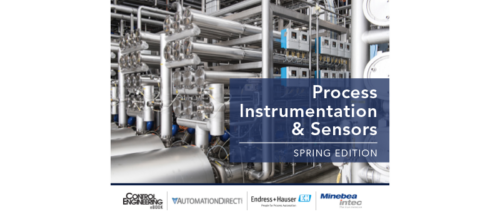Tutorial: Clamp-on ultrasonic flow meters
For transit-time measurements, the transducers need to be far enough apart to create a measurable difference in co- and counter-current travel time as the sound pulse moves through the fluid. Graphic courtesy of Central Station Steam Co.
Sooner or later, you will need to know the flow through some section of piping where you don’t have appropriate instrumentation installed. Ultrasonic flow metering technology is one of the few approaches that allows you to measure what’s going through the pipe without any modification to the pipe. Designs are available that clamp to the outside and take flow readings directly through the walls. While this may sound too good to be true, the technology is well proven and really quite accurate when used properly. Of course, there are limitations, and some applications work better than others.
There are two basic approaches for ultrasonic flow monitoring which apply to clamp-on and permanently mounted sensors:
Doppler ultrasonic flowmeters use two transducers, mounted directly opposite each other. They send a pulse into the fluid stream and take readings of sound reflected from particles entrained in the stream. The amount of shifting indicates the stream velocity which is used to calculate flow. For this to work, there has to be particulate or bubbles capable of reflecting the pulse. Typically, these need to be at least 100 microns (0.004 in.) in diameter, and must be moving at the same speed as the fluid. If the liquid is clear, this won’t work.
Transit-time ultrasonic flowmeters use two transducers mounted some distance upstream from each other. They send signals to each other, and the fluid movement in the pipe causes a measurable difference in the sound transit time as it moves with and against the flow. Depending on the pipe diameter, the signal may go directly between the transducers, or it may bounce from wall to wall. (See graphic.) Like Doppler technology, the sensor measures stream velocity, which translates to flow.
Both technologies have some common characteristics:
Transducer sets operate on a wide variety of pipe sizes, from 1/2 to 100 in. or greater;
Transit-time designs are more precise than Doppler designs, usually
Operating temperatures range from -40 to 185 °F (-40 to 85 °C); and,
Fluid flow is bi-directional.
They also share some common limitations:
For highest accuracy, you need at least 10 diameters of straight pipe upstream and 5 diameters downstream. More than that is better. Elbows, valves, and other devices that disturb laminar flow can drastically reduce accuracy.
The pipe must be full of liquid with no trapped air pockets.
Pipes must be homogenous materials capable of transmitting sound. Materials like concrete, FRP, plastic lined metal pipe, and other composites interfere with sound wave propagation.
Ideally the pipe should have no internal deposits and the outer surface must be clean where the transducer mounts. Sound transmission can be aided by putting grease or similar material on the interface with the pipe wall.
It’s best to mount the transducers on the sides of the pipe at the 3:00 and 9:00 positions, rather than the top and bottom. This avoids any sediment on the pipe bottom.
Bear in mind that this information is general and applies to most manufacturers, but if a point is critical, be sure to discuss it with a specific vendor.
The distance between transducers for a transit-time setup will vary according to pipe diameter. Refer to individual instructions for specifics.
Clamp-on ultrasonic flowmeters are available from a variety of sources, including:
Central Station Steam Co.— www.cadillacmeter.com/ultrasonic/ Dynasonics— www.dynasonics.com/products/doppler.php4 Eesiflo— www.eesiflo.com GE Sensing— www.gesensing.com/products/GC868.htm?bc=bc_panametrics Siemens— pia.khe.siemens.com/index.asp?Nr=13817
You can also search on-line at Control Engineering Supplier Search— www2.kellysearch.com/ctl/
Control Engineering Daily News Desk Peter Welander , process industries editor
Do you have experience and expertise with the topics mentioned in this content? You should consider contributing to our CFE Media editorial team and getting the recognition you and your company deserve. Click here to start this process.


